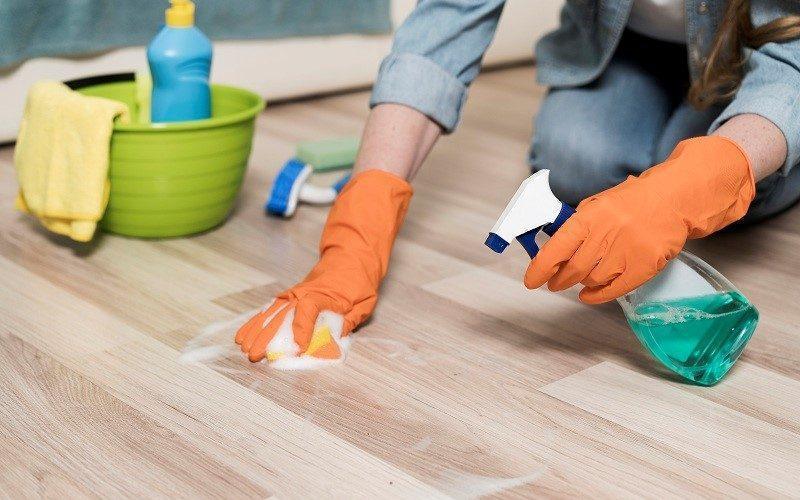
If your home has beautiful floors made of ceramic, porcelain stoneware, marble or granite, you must learn how to properly care for them. Otherwise, they will quickly become dull and lose their original glamour. Our experts have created a complete guide for tile maintenance so you can spend the least amount of time cleaning while getting the best results.
How to Clean Ceramic and Porcelain Stoneware Floors
Porcelain stoneware differs from ceramics in increased strength and a minimum number of pores. It practically does not absorb liquids, does not crack in the cold and withstands impressive loads. Over the years, the surface of porcelain stoneware retains its original beauty – it does not wear out or become scratched. This material is not afraid of the effects of solvents and acids. Does not fade in the sun, does not deteriorate in the rain.
5 Tips on How to Care for Porcelain Stoneware and Ceramic Tile Floors:
Step1. Sweep or vacuum your floor regularly. Due to the layer of dust, the tile quickly fades and loses its brightness. Ceramics are not scratched by abrasive debris but easily lose their lustre. Step2. Buy a suitable mop – use a mop with a microfiber cloth instead of a sponge. The fact is that sponge mops push dirty water into the tile joints, which complicates the further process of cleaning them. Change the water frequently. If you wash the surface with muddy water, you cannot do without dirty stains.
Step3. If your ceramic tile floor looks dull even after damp mopping, you may have used too much detergent. Wipe the surface with lemon water to restore the original shine.
Step4. Do not leave ceramic tiles to air dry as there is a high chance of streaks and streaks. Dry the floor with a lint-free cloth such as rayon or microfiber.
Why do stains appear on ceramic tiles? There are several reasons: dirty water or a rag, poorly rinsed detergent, or you did not sweep the floor before wet cleaning. To avoid streaks, add glass cleaner, vinegar, lemon juice, ammonia, or dishwashing liquid to the water. Never use abrasive cleaning products that damage the glaze. Do you want your tiles to sparkle? Use glass and mirror cleaners.
How to Clean the Seams between Tiles
The real secret to a beautiful tile floor is clean seams. Since they are porous and easily absorb fat and various liquids, they get dirty very quickly. To keep your tiles looking as beautiful as they did on the day of installation, follow these tips for Tiles and Grouts cleaning:
- Make a paste of baking soda and water and apply it to all tile joints. Leave the cleaning mixture on overnight. In the morning, remove the gruel with a stiff nylon brush. When doing this, do not use metal scrapers that easily damage the material.
- Apply silicone-based sealant to the seams to keep them nice and clean. Silicone repels dirt and grease. It is best to apply silicone sealant 2 weeks after laying the tile floor.
How to Properly Clean Marble Tile Floors
Marble makes luxurious tiles, but they require special care. Marble tile floors are cleaned with acid-free detergents. Forget about lemon and vinegar water, bleach and ammonia, which can damage natural stone. Also, stay away from abrasive scrapers and hard-bristled brushes that can leave scratches behind. The same goes for cleaning powders.
The best way to keep your marble floors in top condition is to sweep them regularly with dust mops. We recommend buying mops with a rope, tape or flat mop made of long microfiber fibres. Microfiber is electrified, which effectively attracts dust, hair and animal hair without scratching the surface. But experts advise abandoning the vacuum cleaner.
How to Properly Clean Marble Floors
You will need hot distilled water, neutral pH detergent, soft microfiber mop, dry microfiber cloth and clean water for rinsing.
Since you can’t clean marble tiles with chemicals, hot water is the best way to remove stubborn stains. It is important to use distilled water, which does not leave limestone stains on the surface.
It is important to remember that marble is a porous material that requires mild detergents. Take a microfiber mop and start moving in the direction from the far corner to the exit. Make short strokes and rinse the mop often. Then change the dirty hot water to clean and cool. Go over the marble again to remove any remaining dirt and detergent.
After washing, dry the marble floors thoroughly with a dry microfiber cloth so that they do not have time to absorb moisture. You can use a dry mop or a floor cloth. It’s also handy to wrap the cloth around the mop to mop a large area without having to kneel or bend over.
How to Care for Your Marble Tile Floors
- Marble is a porous material that readily absorbs liquids. Therefore, it is important to clean up spills as they occur. Always keep a microfiber squeegee on hand to dry the surface quickly.
- Do not allow marble tiles to air dry. When the tile dries on its own, it absorbs water and detergent, causing it to become dull. After mopping, always dry your floors with a clean, dry cloth.
- Vinegar is the main enemy of marble. Also avoid using tile cleaners, ammonia, and citrus-infused water. You only need products with a neutral pH level.
- Use a marble floor sealer to protect it from splashes and grease.
- Sweep regularly – dust makes marble dull, and grains of sand leave scratches.
- Marble tile floors are very sensitive to water, which is why experts advise washing them a couple of times a month with a minimum amount of liquid. A spray mop is a great choice. Unlike classic mops, it does not require a rinsing bucket. Its handle has a reservoir from which water is sprayed onto the floor for gentle cleansing.
- Stubborn stains can be removed with soda, but very carefully. Apply baking soda to the stain and gently wipe with a soft cloth without any extra effort. Rinse well with cold water to neutralize the dry with a dry microfiber cloth.
Can you clean marble floors with a steam mop?
Marble tiles are afraid of hot steam as well as water. Regular cleaning with a steam cleaner will remove the sealant from the surface of the natural stone, and further lead to severe damage. Since marble is a very fragile material, it is easily damaged in high humidity and high heat. Under the influence of hot steam, the marble and the solution surrounding it expands, and then, as it cools, it contracts. As a result, marble floors crack and lose their former attractiveness. If you want to take the risk of disinfecting marble tiles with a steam mop, use minimal heat. After steam treatment, dry the surface thoroughly with microfiber.
How to Properly Clean Granite Tile Floors
- Like marble, granite tiles are cleaned with mild, pH-neutral detergents. Do not use bleach, chemicals or abrasive cleaners to clean natural stone.
- Wipe up spilled liquids immediately with a paper towel or soft microfiber cloth.
- Granite tile floors are cleaned in the same way as marble. Use warm, mineral-free distilled water and a microfiber mop. After washing, wipe the surface with a dry cloth.
- If the colour of the granite is light, use hydrogen peroxide to remove the stains. For dark granite, acetone is suitable as a cleaning agent.
- Sweep floors regularly to prevent the build-up of abrasive particles that can cause scratches. Wet cleaning is done once a week.
- Do not use granite polish on the floor. This product is good for countertops, but not suitable for flooring as it makes it slippery.
How not to Clean Granite Tile Floors
If you happen to have natural stone floors in your home, forget about vacuum cleaners, tile cleaners, vinegar, and lemon water. Also, be very careful with baking soda. Instead, stock up on special detergents for washing natural stone, mops and microfiber cloths. Replace hard sweeping brushes with soft dusting mops with long dreadlocks made from microfiber, cotton or viscose.
Stains on granite floors can be removed with warm water and dishwashing detergent. Never rub the tiles in a circular motion as they will damage the surface. Always move in straight lines.





